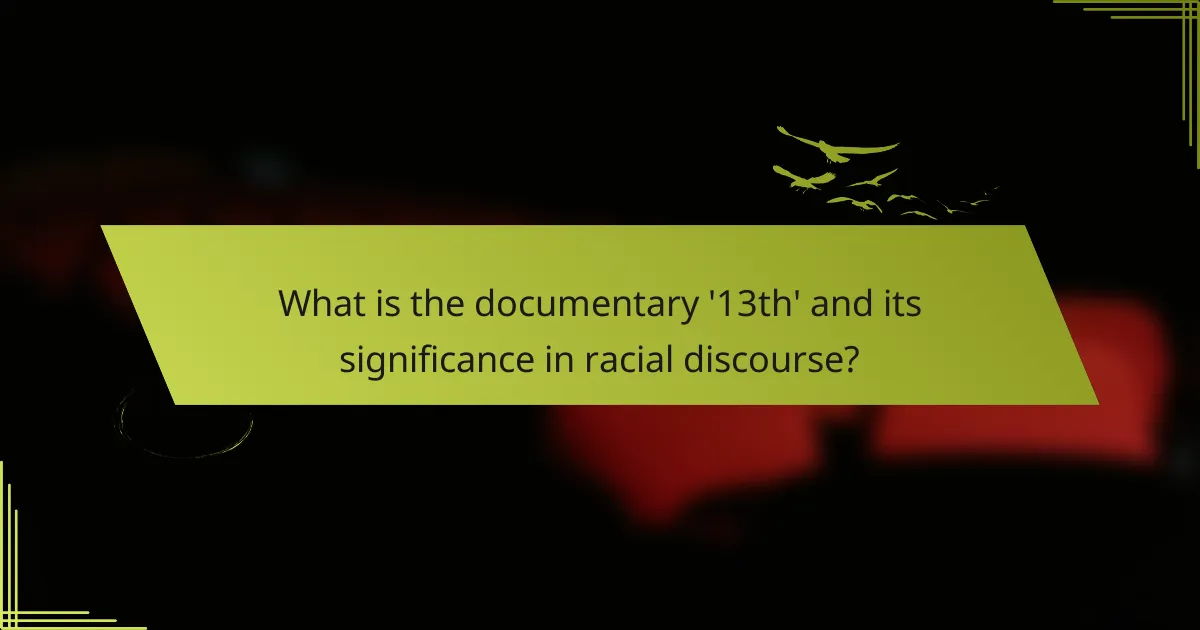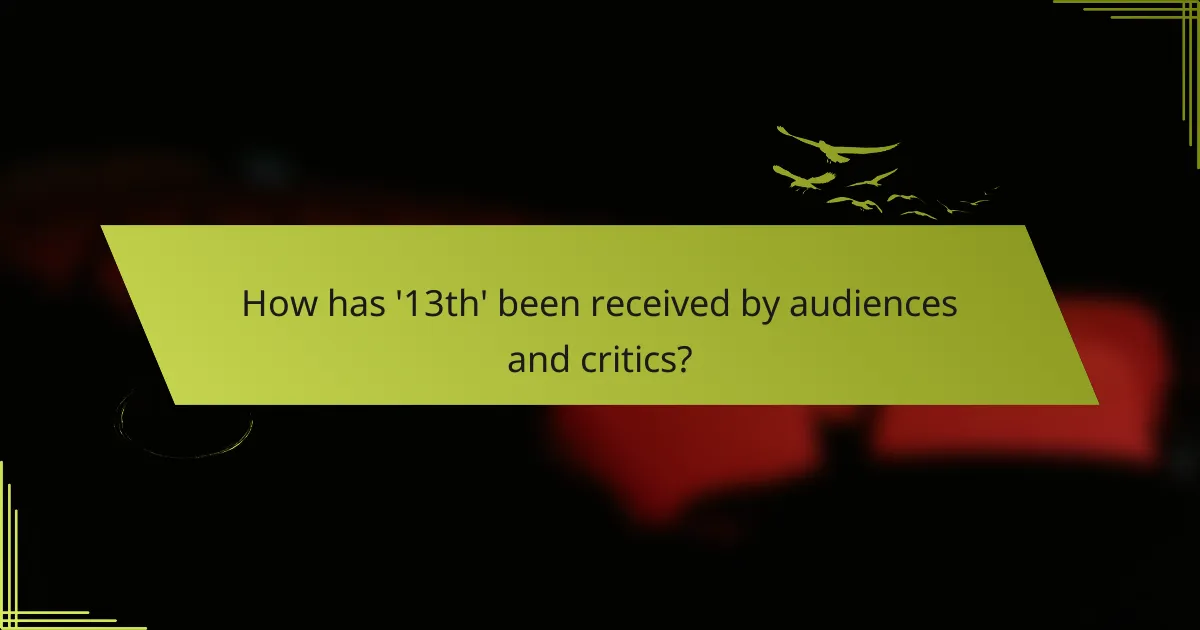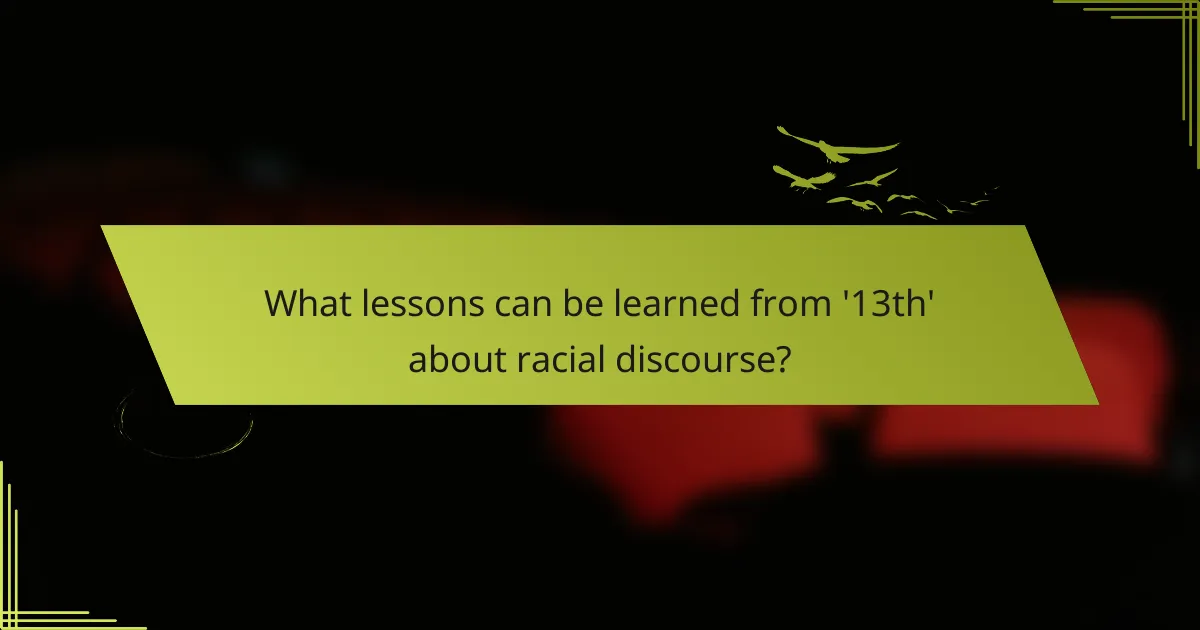
What is the documentary ’13th’ and its significance in racial discourse?
The documentary ’13th’ is a film directed by Ava DuVernay. It explores the history of racial inequality in the United States. The title refers to the 13th Amendment, which abolished slavery. The film argues that slavery has evolved into mass incarceration. It highlights systemic racism within the criminal justice system. The documentary features interviews with scholars, activists, and politicians. It uses historical footage and statistics to support its claims. ’13th’ has sparked significant discussions about race and justice in America. It has been praised for its impactful storytelling and thorough research.
How does ’13th’ address the history of racial inequality in the United States?
’13th’ addresses the history of racial inequality in the United States by examining the intersection of race, justice, and mass incarceration. The documentary highlights how the 13th Amendment, which abolished slavery, contains a loophole that permits involuntary servitude as punishment for crime. This loophole has led to systemic racial discrimination and the disproportionate incarceration of African Americans. The film presents historical footage and expert interviews to illustrate how policies and practices have perpetuated racial inequality. For instance, it discusses the War on Drugs and its impact on communities of color. ’13th’ also connects contemporary issues of police brutality and mass incarceration to historical events, demonstrating a continuous thread of oppression. Overall, the documentary serves as a critical analysis of the ongoing legacy of racism in the American legal system.
What historical events are highlighted in ’13th’?
’13th’ highlights several key historical events related to racial inequality and the criminal justice system in the United States. The film discusses the passage of the 13th Amendment in 1865, which abolished slavery. It also explores the rise of Jim Crow laws following Reconstruction, which enforced racial segregation. The documentary addresses the Civil Rights Movement of the 1960s, emphasizing the struggle for racial equality. Additionally, it examines the War on Drugs initiated in the 1980s, which disproportionately affected African American communities. The film connects these events to the modern-day mass incarceration crisis. It presents statistics showing that one in three Black males can expect to be incarcerated in their lifetime. These historical events illustrate the systemic racism embedded in American society.
How does ’13th’ connect historical events to contemporary issues?
The documentary “13th” connects historical events to contemporary issues by illustrating the ongoing impact of systemic racism in the United States. It traces the lineage of racial inequality from the abolition of slavery to modern mass incarceration. The film highlights how the 13th Amendment, which abolished slavery, contains a loophole that permits involuntary servitude as punishment for crime. This loophole has been exploited, leading to the disproportionate incarceration of African Americans. Statistics show that while Black Americans make up approximately 13% of the U.S. population, they represent nearly 40% of the prison population. The documentary also links historical events, such as the Civil Rights Movement, to current social justice movements like Black Lives Matter. By using archival footage and expert interviews, “13th” emphasizes the continuity of racial oppression and its relevance today. This connection fosters a deeper understanding of contemporary racial issues rooted in historical injustices.
What themes are explored in ’13th’?
’13th’ explores themes of systemic racism, mass incarceration, and the historical context of racial inequality in the United States. The documentary examines how the 13th Amendment, which abolished slavery, contains a loophole that allows for involuntary servitude as punishment for crime. It highlights the connection between slavery and modern-day incarceration rates, particularly among African Americans. The film discusses the role of media in shaping public perception of race and crime. It also addresses the impact of legislation, such as the War on Drugs, on communities of color. Additionally, ’13th’ emphasizes the importance of activism and awareness in combating racial injustice. These themes collectively illustrate the ongoing struggle for civil rights and equality in America.
How does ’13th’ depict systemic racism?
’13th’ depicts systemic racism by illustrating the historical and contemporary links between race and the criminal justice system. The documentary argues that the 13th Amendment, while abolishing slavery, contains a loophole that allows for involuntary servitude as punishment for crime. This loophole has led to the mass incarceration of African Americans. The film presents statistics showing that one in three Black boys born today may be incarcerated in their lifetime. It highlights the role of media in perpetuating stereotypes that justify racial profiling and harsh sentencing. The documentary also connects the rise of the prison-industrial complex to economic interests that profit from incarceration. By providing historical context and current data, ’13th’ effectively demonstrates how systemic racism is embedded in legal and social structures.
What role does the prison-industrial complex play in ’13th’?
The prison-industrial complex is a central theme in ’13th’. The documentary illustrates how the U.S. prison system is intertwined with systemic racism. It argues that mass incarceration is a continuation of racial oppression. The film highlights the economic incentives driving the expansion of prisons. It connects the 13th Amendment’s loophole to the exploitation of incarcerated individuals. The documentary presents statistics showing the disproportionate incarceration rates of Black Americans. It emphasizes how private prison companies profit from high incarceration rates. The narrative critiques policies that perpetuate this cycle of oppression.
What techniques does ’13th’ use to convey its message?
’13th’ employs a combination of archival footage, expert interviews, and powerful narration to convey its message. Archival footage provides historical context, illustrating systemic racism and the evolution of mass incarceration. Expert interviews with scholars and activists offer insights and analysis, reinforcing the documentary’s arguments. The narration, delivered by Ava DuVernay, guides viewers through complex themes. The film also utilizes statistics and visual graphics to emphasize key points. These techniques create a compelling narrative that engages viewers emotionally and intellectually. The integration of personal stories adds a human element, making the statistics relatable. Overall, these methods effectively highlight the film’s central thesis about racial inequality in the criminal justice system.
How does the use of archival footage enhance the narrative in ’13th’?
The use of archival footage enhances the narrative in ’13th’ by providing historical context. It connects past events to contemporary issues of racial injustice. This footage illustrates systemic racism and the evolution of the prison industrial complex. Specific examples include images from civil rights protests and legislations. These visuals evoke emotional responses and increase viewer engagement. They also serve as evidence of the ongoing struggles faced by African Americans. By integrating real historical moments, the film strengthens its argument about inequality. Overall, archival footage deepens the audience’s understanding of the narrative’s themes.
What storytelling techniques are employed in ’13th’ to engage viewers?
’13th’ employs various storytelling techniques to engage viewers effectively. The film utilizes a documentary format that combines interviews, archival footage, and animated graphics. This mix creates a compelling narrative that captures the audience’s attention. The use of personal testimonies from activists and scholars adds emotional depth to the content. The film also incorporates historical context, linking past injustices to contemporary issues. This technique helps viewers understand the ongoing impact of systemic racism. Additionally, the pacing and editing maintain a sense of urgency throughout the film. The strategic use of statistics reinforces the arguments presented, making the narrative more persuasive. Overall, these techniques work together to create a powerful and thought-provoking viewing experience.

How has ’13th’ been received by audiences and critics?
’13th’ has been well received by both audiences and critics. The documentary holds a 97% approval rating on Rotten Tomatoes. Critics praise its compelling narrative and thorough research. It has sparked significant discussions about systemic racism and mass incarceration. Audiences have found it to be informative and eye-opening. The film has won numerous awards, including an Emmy for Outstanding Documentary. Its impact on racial discourse has been widely acknowledged in media reviews.
What are the critical responses to ’13th’?
Critical responses to ’13th’ highlight its powerful examination of systemic racism. Critics praise its thorough historical analysis of the U.S. prison system. The documentary effectively connects the past to contemporary issues of mass incarceration. Many reviews commend Ava DuVernay’s direction for its emotional impact. Some critics argue it oversimplifies complex issues. Others note it successfully raises awareness about racial injustice. The film has sparked significant discussions in media and academia. Overall, it is recognized for its contribution to racial discourse.
How do critics assess the effectiveness of ’13th’ in sparking dialogue?
Critics assess the effectiveness of ’13th’ in sparking dialogue as significant and impactful. The documentary effectively highlights systemic racism and mass incarceration in America. Critics note its use of historical context to frame contemporary issues. The film’s narrative structure engages viewers emotionally and intellectually. Many reviews emphasize its ability to provoke discussion among diverse audiences. Research indicates that ’13th’ has been widely discussed in academic and public forums. This dialogue often extends to social media, amplifying its reach. Overall, critics agree that ’13th’ successfully initiates crucial conversations about race and justice.
What accolades has ’13th’ received since its release?
’13th’ has received numerous accolades since its release. It was nominated for an Academy Award for Best Documentary Feature in 2017. The film won the Primetime Emmy Award for Outstanding Documentary or Nonfiction Special in 2017. Additionally, it received a Peabody Award in 2017 for its impactful storytelling. ’13th’ also garnered recognition from various film festivals. It won the Audience Award for Best Documentary at the 2016 AFI Fest. The film was praised by critics and audiences alike, contributing to discussions on racial injustice. These accolades highlight its significance in contemporary discourse on race.
How has ’13th’ influenced public perception of racial issues?
’13th’ has significantly influenced public perception of racial issues by highlighting systemic racism in the U.S. prison system. The documentary argues that mass incarceration is a continuation of racial oppression. It connects historical context, such as slavery and Jim Crow laws, to modern policies. This linkage has sparked widespread discussions about racial inequality. The film employs powerful statistics, revealing that African Americans are disproportionately incarcerated. Viewers are prompted to reconsider their understanding of race and justice. The documentary has also inspired activism and policy discussions. Overall, ’13th’ has reshaped narratives surrounding race and criminal justice.
What impact has ’13th’ had on discussions around criminal justice reform?
’13th’ has significantly influenced discussions around criminal justice reform. The documentary highlights the historical context of racial inequality and mass incarceration. It connects the 13th Amendment’s loophole to systemic racism in the U.S. criminal justice system. This connection has prompted policymakers to reassess laws and practices. Advocacy groups have used insights from ’13th’ to push for reforms. For example, discussions on ending cash bail and reducing mandatory minimum sentences have gained traction. The film’s impact is evident in increased public awareness and activism. As a result, ’13th’ has become a catalyst for ongoing dialogues about equity and justice reform.
How have educational institutions incorporated ’13th’ into their curricula?
Educational institutions have incorporated ’13th’ into their curricula by using it as a teaching tool for discussions on race and justice. Many colleges and universities include the documentary in courses related to sociology, criminal justice, and African American studies. Educators utilize ’13th’ to highlight systemic racism and mass incarceration in the United States. The film serves as a case study for analyzing historical and contemporary issues of racial inequality. Some institutions organize screenings followed by discussions to engage students critically. Additionally, lesson plans have been developed to align with the themes presented in ’13th’. These plans often include assignments that encourage students to explore related topics in depth. Overall, ’13th’ has become a significant resource for fostering critical dialogue on race in educational settings.

What lessons can be learned from ’13th’ about racial discourse?
’13th’ highlights the systemic nature of racial injustice in the United States. It illustrates how the criminal justice system perpetuates racial inequality. The film connects historical events to contemporary issues. It emphasizes the role of media in shaping public perception of race. ’13th’ reveals the impact of language in racial discourse. It shows how terms like “criminal” are racially charged. The documentary encourages critical examination of societal narratives. It calls for awareness of the historical context behind racial issues.
How can viewers engage with the themes presented in ’13th’?
Viewers can engage with the themes presented in ’13th’ by actively reflecting on the historical context of racial injustice. The documentary highlights systemic racism and mass incarceration in the United States. Viewers can analyze their own biases and the societal structures that perpetuate inequality. Engaging in discussions with others about the film’s themes can deepen understanding. Participating in community events or forums focused on racial issues can also be beneficial. Additionally, viewers can seek out educational resources to further explore the topics presented. Research indicates that films like ’13th’ can prompt social action and awareness among audiences. The film’s impact is evident in increased conversations about race and justice.
What actions can individuals take to address systemic racism in their communities?
Individuals can take several actions to address systemic racism in their communities. They can educate themselves and others about the history and impact of systemic racism. This knowledge empowers individuals to recognize and challenge racist behaviors and policies. Volunteering with local organizations that advocate for racial justice is another effective action. Engaging in community discussions about race can foster understanding and solidarity. Supporting minority-owned businesses helps to promote economic equity. Individuals can also participate in peaceful protests to raise awareness. Voting for policies and candidates that prioritize racial equity is crucial. Lastly, individuals should hold themselves and others accountable for racist actions. Each of these actions contributes to dismantling systemic racism and promoting a more equitable society.
How can discussions around ’13th’ lead to meaningful change?
Discussions around ’13th’ can lead to meaningful change by raising awareness about systemic racism and mass incarceration. The documentary highlights the historical context of the 13th Amendment and its implications. By providing factual evidence, it encourages viewers to question existing narratives. Engaging in dialogue fosters critical thinking and empathy among audiences. This can mobilize communities towards advocacy and policy reform. For instance, increased awareness has led to movements like Black Lives Matter. These discussions inspire individuals to take action and hold institutions accountable. Ultimately, they create a platform for marginalized voices to be heard and valued.
The primary entity of this article is the documentary ’13th’ directed by Ava DuVernay. The article examines the film’s exploration of racial inequality in the United States, focusing on how the 13th Amendment’s loophole has contributed to systemic racism and mass incarceration. It discusses key historical events highlighted in the documentary, the themes of systemic racism and criminal justice reform, and the techniques used to engage viewers. Additionally, the article reviews the critical reception of ’13th’, its impact on public perception of racial issues, and its role in sparking dialogue around criminal justice reform and activism.